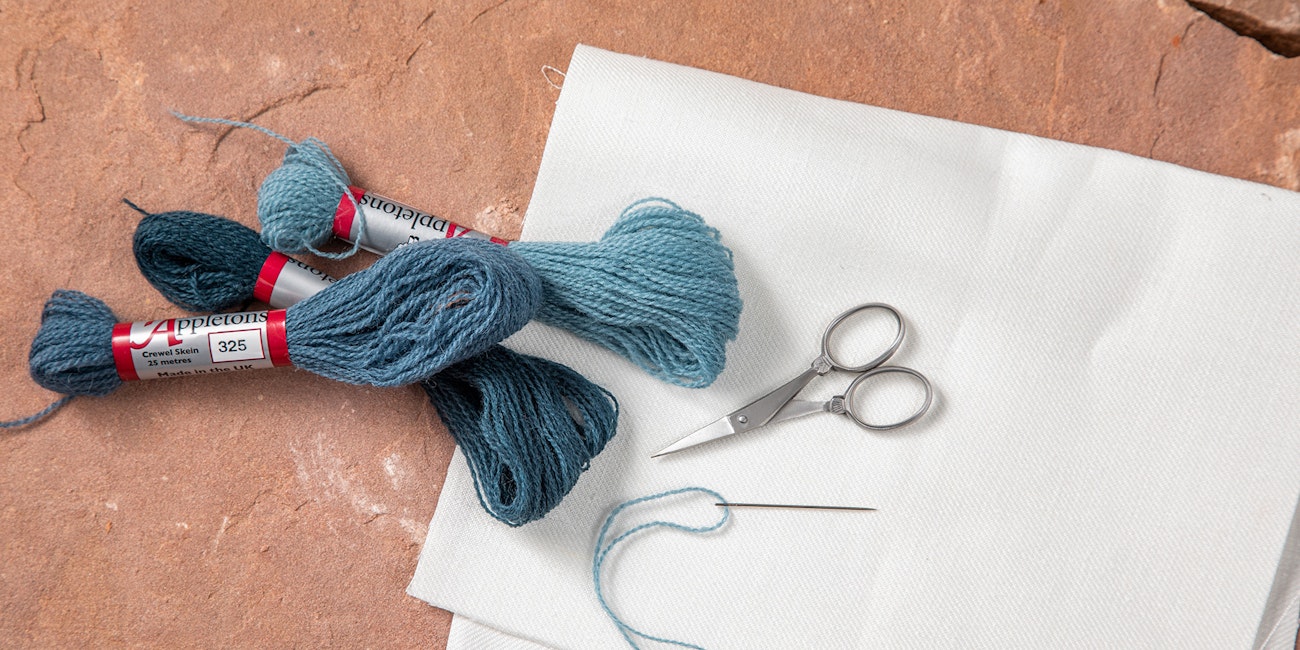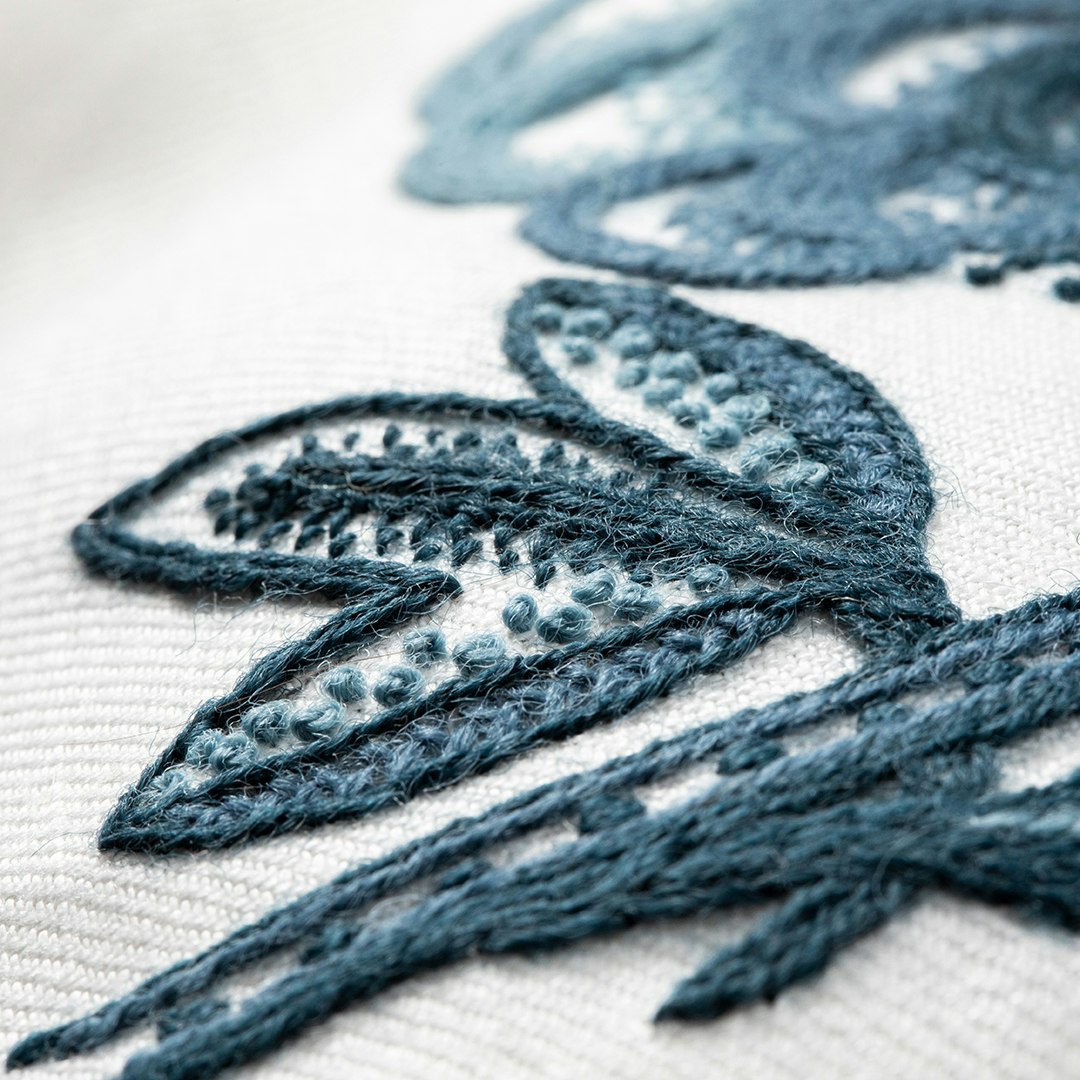Wool is a strong, flexible natural fiber cultivated in more than 200 sheep breeds worldwide. The length of a fleece fiber (staple) helps determine its ultimate use and is classified as short, medium, or long, with the medium to long lengths generally used for embroidery wool yarns. Fleeces come in a wide range of naturally occurring colors such as black, brown, gray, white, and combinations of these colors. Wool can be dyed, with some fleece types accepting dye more readily than others. Projects crafted from wool can have remarkable longevity—centuries, in fact!
England has a long and important sheep breeding and wool producing history. Some longwool British sheep are thought to have descended from the sheep originally brought by the invading Romans during the 1st century CE. From the Middle Ages (1108–1453), sheep and wool became major British exports, allowing the sheep-rearing villages to become very wealthy and powerful. This was especially true of the Cotswold region, where a present-day village visitor can still see the remnants of the ancient wool markets. The Appletons crewel yarn used in the drawn-string bag in PieceWork Winter 2022 came from the Yorkshire area.
 Appleton wool yarns used in Deanna’s project
Appleton wool yarns used in Deanna’s project
Types of Wool Yarn for Needlework
Tapestry yarn is a soft, pliable, tightly twisted 4-ply yarn that should not be separated into individual strands. Normally, tapestry yarn is stitched on size 10- to 12-count mono or interlocked needlepoint canvas or 10/20 count Penelope canvas, as it covers these canvas sizes without packing the holes too tightly with yarn. Tapestry yarn is available in many color families with many shades within each of these families.
Persian yarn is a three-stranded, loosely twisted wool yarn with each strand consisting of 2 plies. This yarn should always be separated into its individual strands and subsequently used as a single stand or recombined into multi-stranded yarn lengths. Persian yarn is the most popular wool yarn used for needlepoint canvases today because of its availability, versatility, and tremendous number of color families and the many shades within each family. This yarn can also be used as a surface embroidery yarn. Persian yarn is very long wearing.
Crewel yarn is a fine, loosely twisted, 2-ply worsted wool yarn that is used as is, or the strands can be combined for more coverage. Using this particular yarn for surface embroidery began much earlier than the 11th century, when the earliest surviving European crewel piece, the Bayeaux Tapestry, was stitched. Jacobean crewelwork began in earnest in Britain in the 17th century and eventually flowed to Colonial America during the 18th century.
Some miscellaneous laceweight and fingering-weight wool yarns can also be used for embroidery, although they may not be as sturdy as yarns that are created for the needlework market. Of course, all wool yarns can be couched to fabric surfaces.
 Wool gives more depth to stitches and fluffs out to fill the spaces.
Wool gives more depth to stitches and fluffs out to fill the spaces.
Why wool yarn?
Because of its basic makeup, wool yarns spread slightly and therefore fill in a design area more easily and quickly. Persian and crewel yarns blend together more easily than cotton or linen threads due to this spread, but also because the tiny fibers extending from the yarn intermingle with each other, especially when working such embroidery stitches as satin and long-and-short. The ability to blend also makes mixing strands of different shades in the needle very effective. Wool yarns enhance a textured embroidery piece.
Wool yarns can be stitched onto fabrics such as felt, cotton or linen twill, wool, needlepoint canvas, counted-thread fabrics (Aida, evenweaves), knitted and crocheted fabrics, and even heavier fabrics such as denim. To prevent puckering of the foundation material and to more accurately place each stitch, always tension the fabric in an embroidery hoop or frame.
Using the correct needle size and type is important. Tapestry, chenille, and embroidery/crewel needles have large eyes to accommodate the yarn size and a wide body to create large holes in the foundation fabrics. This keeps the yarn from excessively rubbing on the fabric during the stitching process. A blunt needle is used for needlepoint canvases and evenweave fabrics, but a sharp needle should always be used when the yarn is to pierce the foundation fabric. Match the yarn weight or strand number to the correct needle size and the fabric weight and type. Using short yarn lengths of 16–18 inches (41–46 cm) reduces yarn abrasion as it’s being pulled through the fabric repeatedly.
Wool yarn—what’s not to love about working with this wonderfully versatile, luxurious, beautiful stitching medium?
Deanna Hall West is a former needlework technical editor for PieceWork and former editor of The Needleworker magazine.

